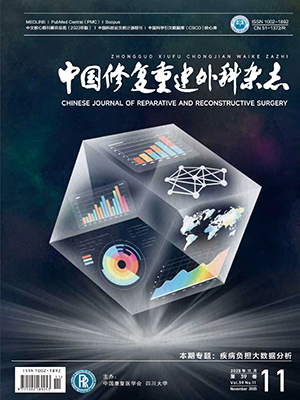Objective To identify the effect of β-endorphin in the development of paresthesia in hypertrophic scar by detecting the expression and content of β-endorphin in human normal skin and hypertrophic scar. Methods Hypertrophic scar samples were collected from 42 patients with hypertrophic scar for 1-20 years (mean, 4.5 years), including 15 males and
27 females with an average age of 32.6 years (range, 16-50 years). According to the kind of paresthesia, they were divided into 3 gourps: non-pain-pruritus group (n=20), pruritus group (n=14), and pain-pruritus group (n=8). Normal skin samples (normal skin group) were harvested from 5 patients undergoing skin grafting surgery, including 3 males and 2 females with an average age of 24.6 years (range, 15-37 years). The immunofluorescence method was used to observe the expression of β-endorphin and ELISA method to detect the concentrations of β-endorphin in the tissues. Results The β-endorphin expressed in all samples, and it expressed around peri pheral nerve fibers in the dermis, fibroblasts, and monocytoid cells princi pally; and it expressed significantly ber in pruritus group and pain-pruritus group than in non-pain-pruritus group and normal skin group. The β-endorphin content was (617.401 ± 97.518) pg/mL in non-pain-pruritus group, (739.543 ± 94.149) pg/mL in pruritus group, (623.294 ± 149.613) pg/mL in pain-pruritus group, and (319.734 ± 85.301) pg/mL in normal skin group; it was significantly higher in non-pain-pruritus group, pruritus group, and pain-pruritus group than in normal skin group (P lt; 0.05); it was significantly higher in pruritus group than in non-pain-pruritus group and pain-pruritus group (P lt; 0.05); and there was no significant difference between non-pain-pruritus group and pain-pruritus group (P gt; 0.05). Conclusion The expression of β-endorphin is high in hypertrophic scar, it may paly an important role in process of pruritus in these patients.
Citation: ZHU Jiangting,CHENG Biao,LIU Hongwei,TANG Jianbing,XIANG Xiaofei,PENG Yan. EXPRESSION OF β-ENDORPHIN IN HYPERTROPHIC SCAR AND ITS RELATIONSHIP WITH PRURITUS. Chinese Journal of Reparative and Reconstructive Surgery, 2012, 26(6): 731-734. doi: Copy
Copyright ? the editorial department of Chinese Journal of Reparative and Reconstructive Surgery of West China Medical Publisher. All rights reserved




